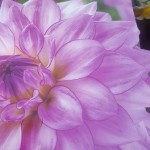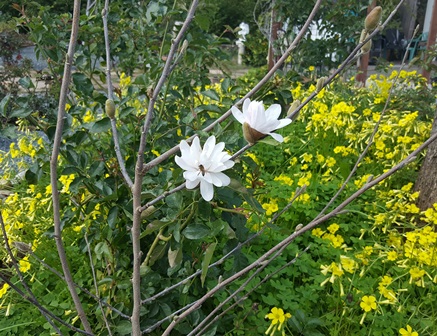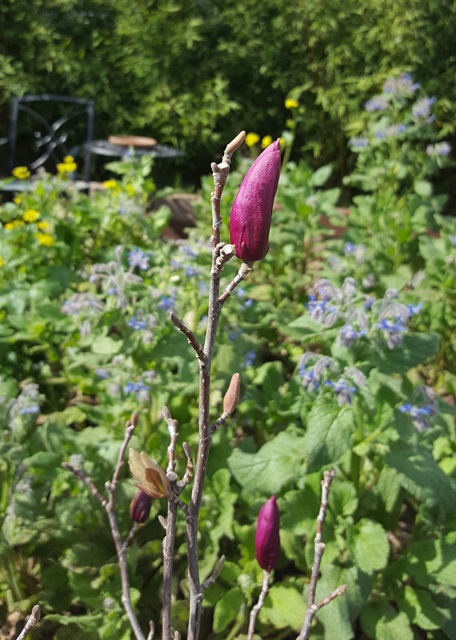Plant Dahlias and Canna Lilies Now for Dazzling Summer Color
Love the tropical foliage and brilliant color of dahlia and Canna lily blooms? Plant them now through April if you live in Zones 8 through 11. Long prized as cut flowers for bouquets, dahlias and Canna lilies do not fail to dazzle also when grouped in flowerbeds alone or with other summer blooming plants.
Indigenous to Central Mexico, dahlias are herbaceous, leafy plants that offer blooms in a wide assortment of colors (except blue and black). Bloom size ranges from a couple of inches across to roughly a foot wide (the largest size is known as “dinner-plate”). Tall varieties need staking and all types can benefit from dead-heading when blooms are spent.
Dahlia roots are actually tubers and do best when planted in moist, well-drained, loamy soil. If growing them in areas where there is frost, dig and store the tubers in a cool, dry (and frost-free) place in the fall for re-planting the next year. In extreme climates like the high desert, dahlias benefit from several inches of mulch covering the bed.
The main pests of dahlias are slugs, snails, earwigs, leaf hoppers, and aphids. Powdery mildew and gray mold can also infect the plant.
Canna lilies, like dahlias, are herbaceous summer-blooming plants that come in a wide variety of colors. Indigenous to sub-tropical areas of North and South America, Cannas can be grown as perennials in zones 7 through 11, according to the U.S. Department of Agriculture. In other zones with more extreme climates, mulch the plants two to four inches deep or lift the rhizomes (roots) and store them in dry peat moss in a cool, dry place until ready to replant.
Plant rhizomes of tall Canna lilies at the back of the flowerbed (or at the front of the bed if the plants are dwarf) in three to six inches of rich, well-drained soil. Position so that the eyes are facing up. Pests include slugs, snails, Canna leaf-rollers, and Japanese beetles. Aphids can spread canna viruses that can cause leaf streaking and bloom disfigurement. The plants are heavy feeders so will need a good organic fertilizer when they begin to look ratty and two to four inches of water each week.
Use tall dahlias and Canna lilies at the back of your flowerbed and add mid-size blooming plants in the middle and dwarf or low growing bedding plants with lots of color at the front to create a spectacular garden area this summer. If you live in a relatively frost-free zone, your dahlias and Canna lilies will spring back to life and carry on with colorful displays amid tropical foliage for years to come.
__________________________________________________________________________________
If you enjoy reading about gardening and the natural world, check out my series of cozy mysteries that include information on growing heirloom plants and keeping chickens and bees. Also see my self-help empowerment and well-being books. All are available online and in bookstores everywhere.

The Henny Penny Farmette series of cozy mysteries–lots of delicious recipes and information for country living
CLICK ON THE LINK to see more.
The Star of Spring–the Mighty Magnolia
My spouse hails from the Caribbean where a variety of magnolias grow, but many in the islands are under threat from deforestation and small distributions. He’s wanted to plant a magnolia tree since we moved to the farmette. Recently, on a rainy evening, we ventured out to our local nursery and purchased a Royal Star and a Jane magnolia for the large entrance area at the front of our property.
Often, it is the m. grandiflora that comes to mind when someone mentions a magnolia tree. It’s a big evergreen tree with glossy leaves, large tulip-shaped white flowers, and dense canopy. This tree blooms summer and fall, while other types of magnolias bloom before their leaves show in the spring.
Magnolias offer gardeners many options–evergreen or deciduous types, wide-range of flower colors, slow or fast-growing trees, and small to large and stately specimens. Named for the French botanist Pierre Magnol (1638-1715), the genus includes about 100 species.
Magnolia blossoms are fragrant and attract various pollinators. While some magnolias grow well in containers for a few years or as espaliers, the larger, showy trees are often planted along city streets and in parks.
Until we have settled on the exact planting site for each of our magnolias, they will remain in their pots. Where to plant them is an important decision since magnolias do not like to be moved once established. As a general rule, they need rich well-drained soil and benefit when the soil has plenty of organic matter like leaf mold, peat moss, and ground bark mixed in at planting time.
Magnolia trees must be planted no lower than their original soil level (where the trunk begins in the planting pot). Because they need plenty of water until established, it’s a good idea to dig a watering basin around them. Young trees must be staked to protect against wind damage.
We chose the Royal Star magnolia (magnolia stellata) because it can hold abundant and spectacular white (or pink) perfumed blossoms throughout spring into summer. Reaching a height of 15 feet with a canopy spread to 10 feet, this beauty looks magnificent against a garden fence. Such a barrier will help protect it against the wind and also create a foil for the blossoms. Come autumn, songbirds will feast on the high-fat content of the star magnolia’s capsules of orange seeds.
The Jane magnolia is one in a Little Girl series of hybrid magnolias that include: Ann, Betty, Judy, Pinkie, Randy, Ricki, and Susan. These magnolias were developed in the mid-1950s at the National Arboretum by Francis DeVos and William Kosar. Jane has large-cup flowers opening reddish-purple with white interiors. Shortly after the blossoms show, the leaves emerge as a coppery-red before turning green.
At the moment, our Jane magnolia, with its roots balled and wrapped in burlap and looking like a shrubby bush, is covered with an abundance of buds as yet unfurled. The buds hold the promise of the fragrant purple blossoms in a couple of weeks. This slow-growing magnolia will reach a height of 10 feet with a 10-foot canopy spread. The plant will be a sure show-stopper in any Northern California garden, especially in spring.
* * *
If you enjoy reading about gardening or other farm topics like keeping bees and chickens, check out my cozy mysteries–A BEELINE TO MURDER, THE MURDER OF A QUEEN BEE, and (coming Sept. 2017) A HIVE OF HOMICIDES (in the Henny Penny Farmette series from Kensington Publishing).
My farm-based novels feature delicious recipes, farming tips, chicken and beekeeping tips, sayings and, of course, a charming cozy mystery. The books are available through online retailers such as Amazon, Barnes & Noble, Target, BAM, Kobo Books, and Walmart as well as from traditional bookstores everywhere.
See, http://tinyurl.com/hxy3s8q
See, http://tinyurl.com/h4kou4g
See, http://tinyurl.com/zsxqmm3
 Facebook
Facebook Goodreads
Goodreads LinkedIn
LinkedIn Meera Lester
Meera Lester Twitter
Twitter














